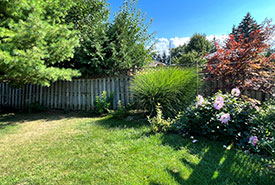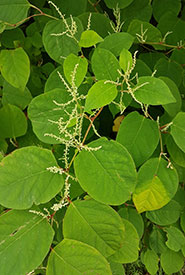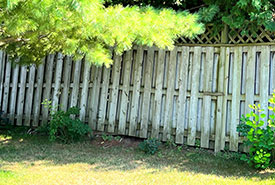A "knot" so regular day in the garden

The back-garden (photo by Luca Brunato)
Back in late spring of 2020, I went back to my hometown of Niagara-on-the-Lake to help my father with the garden. This is an annual practice where I come over, and we spend the entire day weeding, pruning, shaping and landscaping our garden areas around the house. It’s a day of hard work, but it is worth it when we see all the pollinators happily buzzing around our plants.
After a few hours, we finally made it to our back garden. My family home is on a pie-shaped lot, so our back garden is wider than the front. But as we delved deeper into the back part of our garden, we noticed small bamboo-like shoots coming from the ground near our back fence.
In fact, our back fence seemed to be leaning over more than usual. A massive shrub on our neighbour’s lot seemed to be pushing on our fence. My dad climbed the fence to see how massive this shrub really was, and he gasped when he saw the other side. The shrub had completely overtaken our neighbour’s shed and surrounded it on all sides. The shrub itself appeared to also have filled the entirety of our neighbour’s back fence area.
It took me and my dad a little bit of Googling, but we finally realized what we were dealing with. We were not going to be able to manage the weedy situation solely on our own: it was a mature Japanese knotweed.
What is Japanese knotweed?
That was the question both my father and I pondered as we looked at photos and descriptions of this shrub on our Google search. The words “restricted species” really jumped out at my dad. Japanese knotweed is a perennial shrub that belongs to the buckwheat family. First introduced in the 1800s, it was planted for ornamental purposes and to reduce erosion on riverbanks.

Japanese Knotweed (Photo by mitchliliana, CC by NC)
The shrub seems to have found its way into most provinces across the country, as the winged, triangular seeds of Japanese knotweed can just as easily fly through the air as they can get lodged in a shoe.
The most terrifying thing about the plant was its root structure. We were expecting a large root structure due to the size of the plant; however, we were not expecting it to possibly grow 10 metres from the parent stem. These roots can also cause serious damage to home foundations as they can go through concrete and asphalt! My dad’s face turned white. He ran to our shed and brought out our heavy-duty shovels. Suddenly, we were digging up our backyard to see how far much of our yard had been overrun by the roots. Luckily, it appeared that the roots were only just starting to creep into our yard.
Getting the knots out
When you are dealing with cross-property invasive species, the first piece of advice I can give you is to go to your neighbour and explain to them what is going on. Often, they will be on your side when you explain that there is an invasive species — on both of your properties. The second is to contact your local Invasive Species Council so that they can record its location and provide resources for how to take care of it.
In our case, we went to our neighbour’s home and explained our case to her. She was a wonderful elderly woman who seemed all too eager to get rid of that shrub in her backyard. From her point of view, it just appeared one day and started to grow wildly. Once we took the appropriate photos of the parent plant, we sent them to the Ontario Invasive Plant Council through the EDDMapS app.
But what is the EDDMapS app, you may be wondering? Well, the EDDMapS is an app developed by the Ontario Invasive Plant Council to help you easily identify and report invasive plant species across Ontario. It is a web-based map that allows you to accurately plot the area where you have seen an invasive species. The app works great on both android and Apple devices so its just a matter of finding it in your phone’s app store. From there, we were sent various resources on how best to manage the Japanese knotweed population, which we shared with our neighbour as well.

The affected fence (photo by Luca Brunato)
Now that we have finished all of the appropriate management of the Japanese knotweed, our side of the back fence is clear of any Japanese knotweed roots. All that we had to do was manually remove the roots and any rhizomes we found in our garden and use a bit of herbicide to make sure it wouldn’t grow back. Our side of the problem was solved very quickly. As for our neighbour, her parent plant is continuously getting sprayed with herbicide to this day. She hired professionals to come into her garden and every few weeks more and more of the bamboo shoots of the parent plant are cut down. Due to the fast growth rate of the plant, this is not as simple of a process for her, but it has been noticeable that the parent plant has been getting shorter and shorter.
Slowly, our neighbour’s side of the fence has begun to clear up with the large bamboo-like stalks becoming fewer and fewer every week. She tells us that it will still take some time to completely remove the plant from her side of the fence as her garden is filled with the roots and rhizomes under the ground. But surely enough, with the help of the professionals she hired, she will be rid of the invasive species by November. As with any invasive species, it is always important to deal with them properly and effectively so that our natural environments — even our backyards — can prosper.


